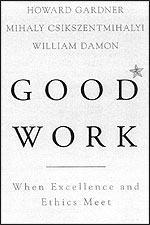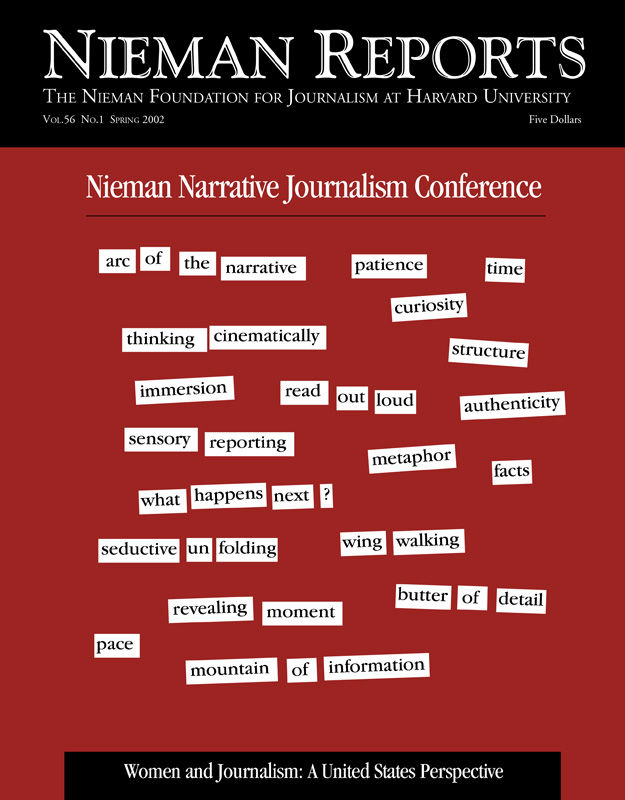
Good Work: When Excellence and Ethics Meet
Howard Gardner, Mihaly Csikszentmihalyi, and William Damon
Basic Books. 304 Pages. $26.
The craft of journalism has rarely drawn serious and sustained attention from major figures in the American academy. There are some glittering exceptions to be sure, but beyond a few historians and a small number of philosophers and legal scholars concerned with the First Amendment, journalism—not “media” or “communications” but journalism—perhaps alone among major American institutions has been either ignored, forgotten or found unworthy of scholarly inquiry. We have more work on brothels than we do on newsrooms.
The decision then of three distinguished psychologists to examine the conditions of “good work” in journalism, to assess the craft and attempt to chart a way forward from vexing difficulties, is a notable and much appreciated event. Whatever the shortcomings of this book, and they are considerable, nothing should lessen the appreciation journalists ought to extend at being taken seriously by gifted, thoughtful academics.
The Project of Good Work, of which this book is the first, is a broad attempt to assay the state of major fields of professional endeavor—law, medicine, theater, philanthropy, higher education—as they are challenged by technological innovation and absorbed into corporate culture and financial markets. The question put to each field is this: What is it that permits and sustains good work, work of expert quality that benefits the broader society?
“Good Work” concentrates on genetics and journalism, here united because one inevitably will control the composition of our bodies, the other the content of our minds. Beyond this handy slogan of similarity, and the ominous introduction of two dystopian works of fiction centered on control of body and mind—Huxley’s “Brave New World” and Orwell’s “1984”—what unites geneticists and journalists is that both are grappling with how to do top quality, socially responsible work at a time when agreed-upon principles and ethical standards are waning, when heroic role models are disappearing, and when ruthlessly competitive markets and rapidly changing technology create vast uncertainty. What differentiates them is that genetics is in the authors’ phrase “well-aligned” because scientists, the general public, and shareholders of corporations agree substantially on goals, whereas journalism has “emerged as a field in which reporters, the general public, and the shareholders of corporations differ sharply in their aspirations.”
The journalism portion of the book is based upon probing, in-depth interviews with more than 100 journalists, including many of the most distinguished practitioners of the craft. In the interviews, they were pressed to state what they considered to be good work, to detail the obstacles placed before their noblest aspirations, and to set forth their hopes, if any, for the future. While a list of interviewees is not revealed, many allowed themselves to be quoted by name throughout the text. The interviews focused on three questions: What is the mission of journalism; that is, why should society reward what journalists do with status and certain privileges? What are the standards and practices of the field through which people best realize the calling? And, what is the moral identity of journalists? Simply put, what is the face in the journalistic mirror that the best practitioners want to see in the morning?
Based upon these interviews, the authors construct a drearily familiar story. This should be a golden age of journalism based upon the talent and wealth available and the importance of the press in contemporary life, but in the eyes of practitioners, it is not. According to the majority of interviewees, the integrity of journalism has been compromised in recent years and obstructions have been placed in the way of good reporting. They are also pessimistic about the future. The demand that journalists work for market share rather than truth and significance, the decline of values and ethics among practitioners, the lack of time to practice the craft, and the need to play to the vulgar interests of the audience have left the craft adrift. As Harold Evans is quoted, “The problem of many organizations is not to stay in business but to stay in journalism.”
Today’s journalists are living off the intellectual investments of their forebears, are awash in entertainment and lurid sensationalism disguised as news, fenced in by an insatiable lust for profits, tyrannized by increasing demands for speed and work within once-proud organizations corrupted as the first families of journalism lose control to financial markets. As a result, the number of young journalists considering alternative careers dwarfs the number in genetics who even mention the possibility. The journalistic ranks are split as editors are absorbed into corporate culture, paid like executives, bribed with stock options, and identify with shareholders rather than the public or their own reporters.
Journalism is at a pivotal moment in its history, for the scales between quality journalism and schlock sensationalism are in a precarious balance; the perception that journalists cannot be trusted and the field is no more than a money-grubbing enterprise, barren of anything but self-serving values, is widespread. If these facts and perceptions continue, we will be robbed, the authors conclude, of our ability to flourish as a society and to adapt as individuals to changing conditions of living.
All this is tough stuff but nothing new. Wisely, the authors recognize that the Hutchins Commission largely predicted this outcome in 1946. The commission was particularly alarmed by the increased economic concentration of the press but was equally sensitive to the growth of damaging practices: premature scoops that were nothing more than gossip and sensationalism, the indiscriminate mixing of fact and opinion, the refusal to cover important stories because they threatened the interests of the powerful. There was a warning in the report: If we allow cherished institutions to diminish, it may not always be possible to reinvigorate them. “In retrospect, it is clear that the Hutchins Commission was ahead of its time and that, lamentably, it went unheard,” the authors write.
What distinguishes “Good Work” is that it is more than an atrocity tale. In a competent, albeit somewhat potted, history of journalism, Gardner and his colleagues tell the story of a proud legacy of moral standards and best practices. Their tracing of the evolution of journalists from printers to partisans to “professionals” highlights the evolution of integrity in journalism and real standards of craftsmanship. This evolution coalesced during the progressive era when good practice became good business, when journalists could pursue their craft skillfully and honorably. These traditions remain part of the resources of journalism. There are moral standards and practices, living traditions of excellence, a sense of mission, pockets within the field (colleagues, employers, institutions, organizations, awards) that still support good work. The authors note with pleasure the attempts that have arisen within the field by the Committee of Concerned Journalists and the Project for Excellence in Journalism, among others, to reaffirm standards and practices. “Good Work” underscores many of the same values affirmed in Bill Kovach and Tom Rosenstiel’s “The Elements of Journalism” (William Damon of Stanford University worked on both): a commitment to free, uncensored, truthful journalism, fairness, dedication to craft, to integrity, to independence, to democracy.
In short, the book encourages journalists to have faith in their own hard-won traditions that have stood the test of time. To that end, they identify strategies of journalists that have been successful even in parlous times: the cultivation of an inner moral conscience, maintaining mental distance from events covered, emphasizing a commitment to pluralism and democracy, expanding the domain of journalism through creative innovation, and the promise of new technology in building institutions of community and democracy.
Alas, the book is marred both by a somewhat uncritical examination of new technology relative to the very traditions of journalism that are honored and by a curt, silly and uniformed dismissal of public or civic journalism based on a misreading of one book and a few equally uninformed comments in interviews.
In all, there are three major shortcomings in the book. The first problem is inadvertent. “Good Work” was written in the hothouse atmospherics of Monica, Linda, Bill and Gary and before September 11, 2001. The gay and irresponsible 1990’s, a collective American vacation from rationality, produced a journalism appropriate to that moment. All we needed, as thoughtful observers realized, was war or recession and the silliness of a silly decade would end. Alas, we got both, but damage had already been done to democratic institutions, including the press, and the underlying tendencies that gave rise to the excess continue below the surface of a much different time.
Second, while the book emphasizes the nobility and traditions of journalists, it completely ignores the ethics and responsibility of ownership of an industry that under the Constitution partakes of a public trust. Unless we can save journalism from current ownership, who treat the First Amendment as a property right guaranteeing profits without regard to the health of the political order, the most strenuous efforts of journalists will be defeated.
Third, many of the problems of contemporary journalism come from the very traditions that Gardner and his colleagues celebrate. For example, while lionizing Bob Woodward’s pioneering transformation of muckraking into investigative reporting, the authors completely ignore the abuses, such as an attempt to ferret out and contact grand jurors hearing the Watergate case, that were excesses but logical extensions of journalistic traditions of investigation, truth telling, and independence. The authors forget there were two wings of the progressive movement. One was populist and led to a celebration of strong and participatory democracy. The other was scientific and managerial and led to a thin democracy of spectators.
Increasingly, journalism followed a scientific and managerial route of independence that freed it of the duties of citizenship, the necessity to respect and obey the law, an indifference to the opinions of ordinary citizens, and a failure to respect a basic tenet of democracy—the separation of public from private life. In the eyes of many, journalism evolved from supporting a thick democracy of participation to one that supported a thin democracy of spectatorship, from a journalism conversing with citizens to a journalism informing, by its own standards and lights, a passive public.
The thing that gives us hope is not simply the renewal of tradition but a recognition of the limitations of that tradition and a commitment to new standards and practices that lets the public back in as an active participant in democratic life. If we need a hopeful example, it can found in recent changes at The New York Times, changes that were not self-conscious exercises in public journalism but instead spirited innovations to deal with changed circumstances. The willingness to admit to error in the Wen Ho Lee case, to pursue a series on race and pluralism in America that was not tied to current events, the “Portraits of Grief” that grew organically out of observing the anguish of the city rather than the statements of the powerful, and even the opening of the paper to greater feedback via e-mail—these are all signs that we may have turned a corner and that journalism might yet be transformed as well as renewed. But still there is, beyond the Times and a few others, the problem of ownership. On that, we are all stumped.
Jim Carey is CBS Professor of International Journalism at the Columbia University Graduate School of Journalism.


